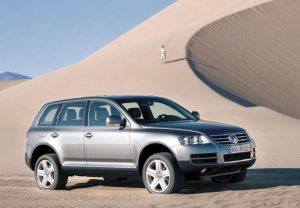Recalls: Volkswagen 7L Touareg
Overview
Manufacturers, or importers, issue recalls for defects or faults which have the potential to cause injury. Generally, manufacturers will inform the original buyers if their vehicle is subject to a recall and of the steps required to remedy the defect or fault. Please note that the recalls below (if any) are for Australian-delivered vehicles only. Furthermore, the number of recalls should not be taken as an indication of a model’s reliability or its safety more generally.
Recalls: Volkswagen 7L Touareg
- In March 2004, a recall was issued for Volkswagen 7L Touareg vehicles manufactured from January 2003 to 8 August 2003. In these vehicles, the park brake pedal may come into contact with and chafe the vehicle’s wiring loom (PRA 2004/6845).
- In September 2004, a recall was issued for Volkswagen 7L Touareg vehicles manufactured from January 2003 to November 2003. For these vehicles, faulty rear seatbelt locks may have been fitted because of a riveting defect (PRA 2004/7223). The recalled vehicles had VINs in the following ranges:
- WVG ZZZ 7L Z3D 011126 to WVG ZZZ 7L Z3D 012301; and,
- WVG ZZZ 7L Z4D 006287 to WVG ZZZ 7L Z4D 046423.
Problems and faults: Volkswagen 7L Touareg
Overview
This section identifies potential problems, causes and fixes based on the experiences of owners and repairers, online sources and technical service bulletins. This information is provided solely for reference purposes and AustralianCar.Reviews recommends that only properly qualified persons carry out repairs or modifications. Furthermore, the number of items below should not be taken as an indicator of a model’s reliability or the frequency with which they may occur.
To report a problem or fault to the AustralianCar.Reviews team, please use the Contact Us form. Note that AustralianCar.Reviews does not offer advice on automotive problems or disputes; such enquiries will not receive a reply. For vehicles purchased from dealers after 1 January 2011, please see our Australian Consumer Law fact sheet.
VW Touareg Diesel V6 engine: NOx emissions “defeat device”
Volkswagen 7L Touareg vehicles powered by 3.0-litre diesel V6 engines (engine code: CASA) that were available for sale from model year 2009 to 2010 have software in the electronic control module (ECM) that can sense – via sensors measuring the position of the steering wheel, vehicle speed, the duration of the engine’s operation and barometric pressure – when the vehicle is undergoing emissions testing. The ECM then operates in a low NOx “temperature conditioning” mode to satisfy emissions standards.
At exactly one second after the completion of the initial phases of the standard test procedure, the software immediately switches to a “normal mode” and changes a number of operating parameters that increased NOx emissions. In other tests where the vehicle did not experience driving conditions similar to the start of the emissions testing procedure, the emissions were higher from the start, consistent with the operation and existence of a “normal mode”.
The software on these vehicles constitutes a “defeat device” since it is an Auxiliary Emissions Control Device (AECD) designed to circumvent emissions testing. Volkswagen has admitted that all its 3.0-litre turbo-diesel engines from ‘model years’ 2009 through to 2016 have defeat devices.
Carbon deposits (build-up) on intake valves
Volkswagen’s naturally aspirated, direct injected petrol engines (such as the Touareg’s 3.6 FSI) are considered susceptible to accumulating carbon deposits (or build up) on the intake valves. In these direct injection petrol engines, carbon deposits may accumulate on the stem and throat of the intake valve due to:
- the vaporisation of oil which is not trapped by the oil separator; or
- unburned fuel and exhaust gases that escape past the piston rings and enter the crankcase (‘blow-by’).
Since direct injection engines do not spray fuel on the backside of the intake valves, the detergent properties of the fuel cannot remove the carbon build up (as occurs in port injected engines). Symptoms of carbon deposits on the intake valve include difficulty starting the vehicle (hard starting), misfiring and misfire engine codes and reduced engine performance. Potentially, these deposits can result in damage to the catalytic converter and, for turbocharged engines, the turbocharger itself if bits of the deposit break off and enter the exhaust. To remove the carbon deposits, the intake must be removed and the valves cleaned manually. To reduce the incidence of carbon deposits, a common aftermarket measure is the fitment of an oil vapor catch can. The catch can receives dirty air from the crankcase via the Positive Crankcase Ventilation (PCV) valve, filters it and returns it to the intake manifold via the PCV port.
Problems and faults: Volkswagen 7L Touareg
- If the wheels bind or scrub and the ESP light illuminates during low speed corners, the differential control module likely requires reprogramming.
- When stationary, the vehicle may sag after sitting because the residual air valve for the suspension becomes corroded; a revised valve was subsequently released.
- Harsh downshifts from fifth to fourth gear and/or delayed engagement may require the transmission control module to be re-flashed.
- The battery may be drained due to the navigation system being kept ‘awake’ by RDS (radio data system) signals, requiring the navigation system to be reprogrammed.
- The battery may be drained and/or the key may not come out of the ignition lock due to a defective battery earth connection under the driver’s seat.
- The interior door handles may not return to their original position when released, requiring the fitment of a clip on the cable inside the door and the door release cable to be re-routed.
- The PRNDS indicator light may illuminate due to a fault with the wiring harness.
- A malfunctioning rain sensor may cause the windscreen wipers to operate at full speed regardless of the amount of rain.
- The remote central locking transmitter may work intermittently or stop working due to loss of synchronization with the vehicle.
- The rear liftgate may not open all the way and revert to a 31 degree angle if the release switch is held for longer than four seconds or if an object is caught under the liftgate switch while closing.
- The parking brake warning light may stay on because the parking brake damper (strut rod) becomes weaker over time and requires replacement.




